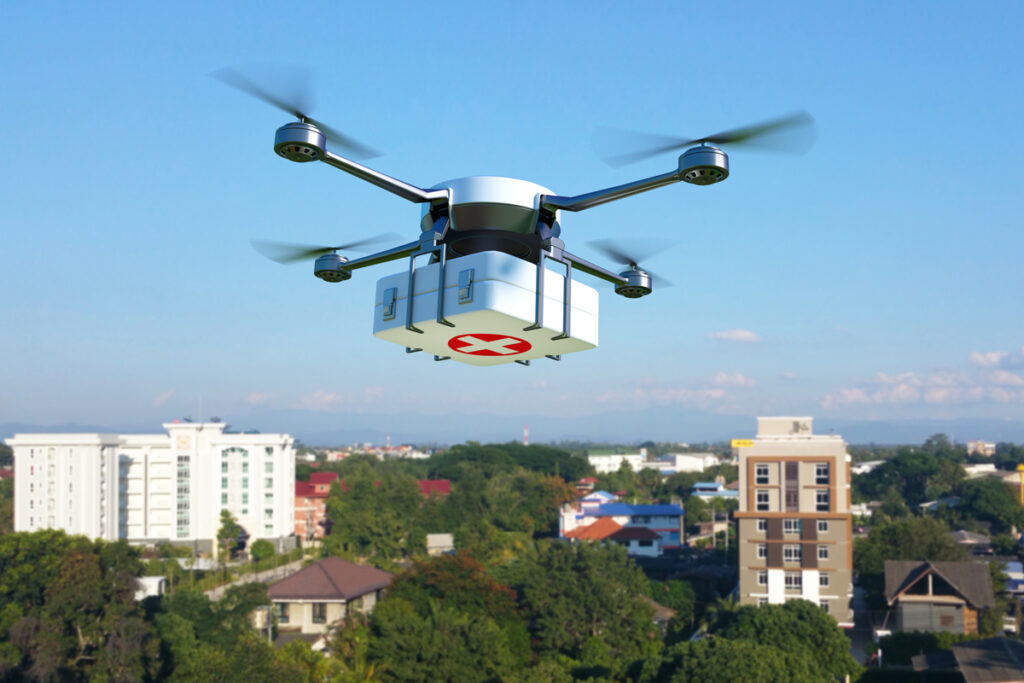How health systems can plan for adding drone deliveries to the supply chain’s capabilities.
February 2022 – The Journal of Healthcare Contracting
By Jody Dobson

“Drone technology has the potential to significantly improve the care we can deliver to our patients … while seamlessly and directly connecting our facilities in a unique way.” – Dr. Stuart Ginn, Commercial Airline Pilot, ENT Surgeon, pioneer of an innovative drone program at Raleigh, North Carolina-based WakeMed Health.1
The use of UAS (Unmanned Aviation Systems) for commercial medical transport in the United States is on the verge of taking off. Today in the United States, Matternet is already working with health systems to operate reliable drone networks for critical medical deliveries.
As supply chain executives build or expand their distribution brick-and-mortar infrastructure, what do they need to take into consideration to accommodate drone deliveries? Medical deliveries by drones will typically fall into two categories:
- Intra-campus and inter-facility movement of critical medical supplies within the health system’s network. This could include blood samples flown from free-standing Emergency Rooms to a centralized laboratory to facilitate faster lab test results for patients. Today, drones are delivering COVID-19 vaccines from a central hospital pharmacy to an off-site vaccine administration site at Wake Forest Baptist Health.2
- Re-supply and redistribution from external suppliers. Health systems will receive commercial drone shipments from vendors and distributors to their distribution centers or directly to the point of patient care.
In this scenario, a regional manufacturer of site-specific tissue called Extracellular Matrices (ECMs) will use drones to provide a new type of “Just in Time” delivery … directly to an off-site Ambulatory Surgery Center. These patient specific deliveries will allow better treatment customization, which will improve patient outcomes. Health systems will have less money tied up in on-hand surgical inventory and worries about product expiration dates will be reduced.
When Bill Moir, Vice President of Supply Chain at Michigan-based Henry Ford Health System, considered the construction of his new distribution center, he took into account deliveries via drone and purposefully incorporated flexible infrastructure. “While there’s a lot we don’t know yet regarding the facilities required to land and deploy drones at scale, I was able to make some general assumptions,” he said.
First, Moir made sure that one of his new loading docks had “drive up” access, instead of the normal loading dock, which can be 4 to 5 feet off the ground. The paved ramp, which is located at the end of the building, will allow drones to be brought into the building on rolling carts.
Moir considered the human element when thinking about how drone deliveries will be handled by his supply chain team. He has the ability to use some flexible space right inside the drive-up ramp for a separate drone management office or as a hangar for afterhours drone storage. He made sure there is adequate power and internet capabilities wired to that end of the building for the charging and connectivity drones require.
Planning for drone deliveries
The following are additional ways that health system supply chain executives can plan the infrastructure that will be necessary to accommodate drone deliveries in the future:
Connectivity and Communication. Drones use cellular service, satellite communications and WIFI. Landing spots between building or around tall structures are not ideal because cell service might be intermittent in these locations.
Power. Drone batteries will need to be recharged between flights. Will you have the power and space to charge multiple batteries at once?
Operational process, through-put and connectivity. How will the drone deliveries be integrated into your established receiving and tracking processes? How will you track drone deliveries made directly to your care sites, labs and pharmacies?
Security and storage. Health system distribution centers will need secure after-hours storage for drones, which the health system may not own. Security will include keeping track of back up drones, spare batteries, landing infrastructure and spare parts. What if drone deliveries are required 24/7?
Work area for maintenance. Drones are considered commercial aircraft and have scheduled maintenance and safety checks that must occur at regular intervals. Plan to have a well-lit work bench area with space to disassemble and maintain drones.
Sound mitigation. Plan to minimize the noise of drone propellers over residential areas or near patient rooms. Fortuitously, Moir’s new distribution center at Henry Ford Health is located in an industrial area, mitigating the impact of drone noise on his neighbors.
Weather. Drones need to be sheltered from high winds, lightening and severe weather. This makes Moir’s ability to roll drones into his distribution center at Henry Ford Health a good idea.
Supply chain executives should consider practical steps they can take today to anticipate a future that includes drone deliveries at scale. This is an exciting and dynamic time, as health systems discover more ways to use drones to improve patient care and drive operational efficiencies.
Jody Dobson is Head Healthcare U.S. for Matternet, a company focused on urban drone utilization for healthcare.
For more information, contact Jody at jody.dobson@Matternet.us, or visit mttr.net.
